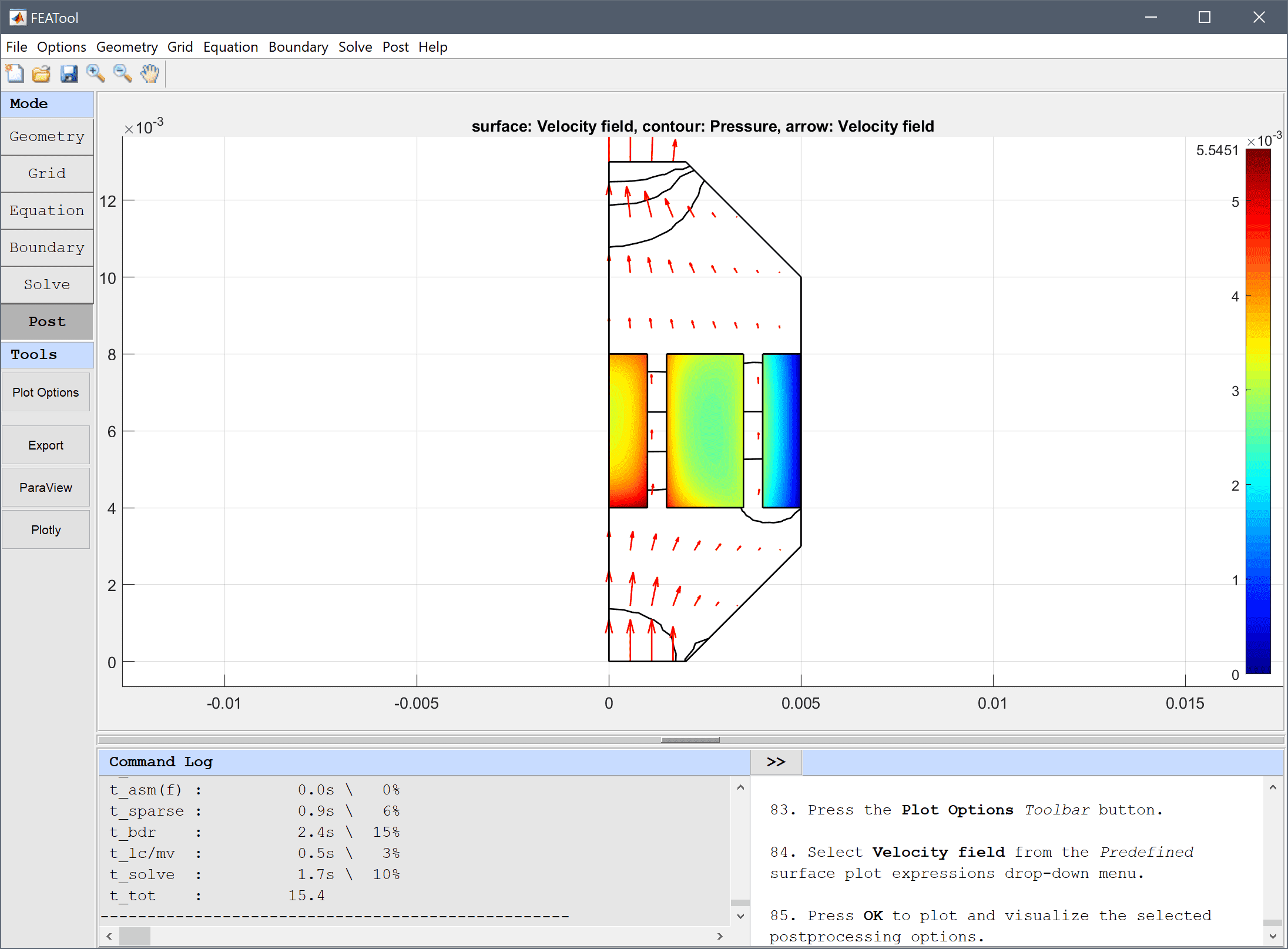
|
FEATool Multiphysics
v1.17.5
Finite Element Analysis Toolbox
|

|
FEATool Multiphysics
v1.17.5
Finite Element Analysis Toolbox
|
Axisymmetric laminar fluid flow in a diffusor duct or reaction chamber blocked by sections of a porous material. The model features several partially active subdomains with the Brinkman equations governing the fluid flow. The flow field with and without the porous material is compared.

This model is available as an automated tutorial by selecting Model Examples and Tutorials... > Multiphysics > Flow in Porous Media from the File menu. Or alternatively, follow the step-by-step instructions below.
First is to solve a pure laminar flow problem without the porous domains.
Enter the following data into the Point coordinates table.
| r | z | |
|---|---|---|
| 1 | 0 | 0 |
| 2 | 0.002 | 0 |
| 3 | 0.005 | 0.003 |
| 4 | 0.005 | 0.01 |
| 5 | 0.002 | 0.013 |
| 6 | 0 | 0.013 |
1e-3 into the xmax edit field.4e-3 into the ymin edit field.8e-3 into the ymax edit field.1.5e-3 into the xmin edit field.3.5e-3 into the xmax edit field.4e-3 into the ymin edit field.8e-3 into the ymax edit field.4e-3 0 into the Space separated string of displacement lengths edit field.Specific grid sizes for subdomains and boundaries can be prescribed directly in the Grid Settings dialog box. Here the grid size in the outer domain is set to three times the porous domains.
1.5e-4*[3 1 1 1] into the Subdomain Grid Size edit field.1.2 into the Density edit field.1.8e-5 into the Viscosity edit field.2e-2 into the Velocity in z-direction edit field.By plotting the Velocity field at the mid point one can see that the flow decreases smoothly towards the edges.
0:0.005/100:0.005 into the Evaluation coordinates in r-direction edit field.0.006 into the Evaluation coordinates in z-direction edit field.Now go back to Equation mode and add the Brinkman Equations physics mode which will account for the porous domains.
1.2 into the Density edit field.1.8e-5 into the Viscosity edit field.2e-7 into the Permeability edit field.Deactivate the Brinkman Equations physics mode in the outer domain.
Similarly, deactivate the Navier-Stokes Equations physics mode in the inner porous domains.
The two physics modes are coupled via setting the corresponding velocities equal at the shared boundaries.
u2 into the Velocity in r-direction edit field.w2 into the Velocity in z-direction edit field.u into the Velocity in r-direction edit field.w into the Velocity in z-direction edit field.There now exists two sets of postprocessing variables, one for each physics mode. Plot and compare the magnitude of the Velocity field for both the porous and outer domains.
Also again plot magnitude of the Velocity field at the mid point line. As nan values are returned for queries outside the valid domain, one can use the setnan function to plot both curves together.
setnan(sqrt(u^2+w^2),0) + setnan(sqrt(u2^2+w2^2),0) into the edit field.0:0.005/100:0.005 into the Evaluation coordinates in r-direction edit field.0.006 into the Evaluation coordinates in z-direction edit field.Compared to the smooth flow before, the flow now is irregular with two peaks between the porous domains.
The flow in porous media multiphysics model has now been completed and can be saved as a binary (.fea) model file, or exported as a programmable MATLAB m-script text file, or GUI script (.fes) file.
To visualize the full 3D solution from the axisymmetic model, the data can be exported and processed on the MATLAB command line interface (CLI) console with the Export Model Data Struct to MATLAB option from the File menu. The postrevolve and postplot functions can then be applied to revolve and visualize the data, for example
fea_revolved = postrevolve( fea, 24, 0.75 );
postplot( fea_revolved, 'surfexpr', 'setnan(sqrt(u^2+w^2)) + setnan(p2*1e1)', ...
'parent', figure, 'axis', 'off', 'colorbar', 'off' )
view(60, 30)